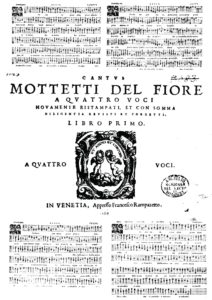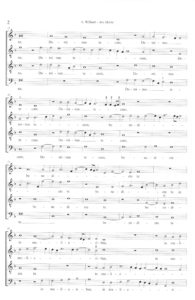Adrian Willaert, Maître de Chapelle à la Basilique Saint-Marc de Venise
Transcription et Analyse de l’Ave Maria à Quatre Voix
Par Andrea Angelini, Rédacteur en chef de l’ICB, chef de chœur et enseignant
Les années entre 1550 et 1560 furent une période d’une prospérité incomparable pour Venise et ses marchands. L’essor économique profita au secteur de l’édition, apportant une croissance rapide du nombre d’imprimeries commerciales. Ceci atteignit son sommet à la fin de 1560, quand l’industrie comptait cinquante à soixante imprimeries employant environ six cents personnes en tout. La situation économique favorable encouragea de nombreux débutants à se lancer dans ce secteur.
Francesco Rampazetto fut un imprimeur actif de 1553 à sa mort en 1577. Il travailla principalement en sous-traitance pour les autres imprimeurs et les libraires. Comme plusieurs de ses collègues, il imprima une grande variété d’ouvrages sur des sujets divers : l’architecture, la littérature, l’astronomie et l’histoire et la musique. La plupart des livres qu’il publia étaient en langue vernaculaire, mais il publia également des livres en latin, en grec et en espagnol. Entre 1561 et 1568, il publia au moins trente deux livres de musique et un de théorie musicale.
Plusieurs de ses publications, comme le Premier Livre de Louanges Spirituelles de Giovanni Razzi (1563, Jacopo et Filippo Giunti, Florence), le Troisième Livre des Muses pour Quatre Voix (1563, Antonio Barré), et le Deuxième Livre de Madrigaux à Cinq Voix de Pietro Vinci (Giovanni Comencino, Venise) confirment son statut de travailleur contractuel pour des clients précis et pour d’autres imprimeurs. La suite de ses premières éditions fut directement commandée par des compositeurs ou des tiers. En 1566 Rampazetto, sur la requête de Filippo Zusberti, chantre à Saint-Marc, imprima le motet à six voix de Zarlino. Il entreprit également de réimprimer des anthologies chorales bien connues des compositeurs de l’époque. Une d’entre elles est intitulée “Mottetti del Fiore”.
Le titre complet de l’œuvre est : Mottetti del Fiore a Quattro voci novamente ristampati, et con somma diligentia revisti et corretti. Libro Primo. – In Venetia, Appresso Francesco Rampazetto. – in 4° obl. Cantus, Tenor, Altus, Bassus. In tutto opuscoli quattro.
(Mottetti del Fiore pour Quatre Voix, nouvellement réimprimé et soigneusement révisé et corrigé. Premier Livre. À Venise, par Francesco Rampazetto. Cantus, Tenor, Altus, Bassus. Quatre livrets en tout.)
Un exemplaire original de l’œuvre est conservé au Musée International de Musique et Bibliothèque de Bologne. Il comporte les titres suivants (Les noms des auteurs sont cités ici tels qu’ils apparaissent dans le document) :
In te Domine speravi … Lerithier
Letetur omne seculum … Lupus
Filie Jerusalem … Archadelt
Panis quem ego dabo … Lupus
Beati omnes … Lerithier
Nisi Dominus … Lerithier
Descendit angelus … Hilaire Penet
Gloriosa uirgo … N. Paignier
Dum aurora … N. Paignier
Virtute magna … Lasson
Tu es Petrus … Gose
Domine quis habitabit ... Jo. Courtois
Benedixit Deus … Archadelt
Aue Santissima Maria … N. Gombert
Fuit homo … N. Gombert
Tanto tempore … Verdelat
Haec dies quam fecit … Archadelt
Beati omnes … Lupus
Sponsa Christi Cecilia … Loiset Pieton
Quam pulchra es … Jo. Lupi
Omnis pulchritudo domini … Dambert
Nisi ego abiero … Dambert
Vir inclitus … F. De Lis
Proba me domine … P. Manchicourt
Quem dicunt homines … Richafort
In conuertendo dominus … Lupus
Gabriel archangelus … Verdelot
Pater noster … Adrianus Wuillart
Pour la transcription, le dernier motet a été consulté. Sa deuxième partie (secunda pars) est un texte de l’“Ave Maria” avec une variante précédant sa classification officielle au cours de l’année 1571, à l’occasion de la bataille de Lepanto. Voici le texte utilisé par Willaert :
Ave Maria, gratia plena,
Dominus tecum,
benedicta tu in mulieribus,
et benedictus fructus ventris tui, Jesus.
Sancta Maria, Regina Coeli,
dulcis et pia, o Mater Dei,
ora pro nobis peccatoribus,
ut cum electis te videamus.
Ce motet, imprimé en 1564, est une des plus belles œuvres de Willaert. Dans son langage, l’imitation n’est pas seulement un artifice, mais une technique renforçant l’expressivité des mots et de leur sens. Naturellement, le fait que Willaert vivait à Venise, où la longue liste d’impératifs fixés lors du Concile de Trente (1545-1562) pour accéder à l’agrément, l’aida à développer un style de composition libre de l’immixtion papale et très influencé par le goût de la couleur vénitienne caractéristique.
Le motet, dans le premier mode (dorien, qui correspond au “Protus authentus” grégorien, transposé en sol, se présente en quatre sections qui correspondent à quatre strophes adressant à la Vierge leur prière. Ces parties sont: “Ave Maria, gratia plena, Dominus tecum”; “Benedicta tu in mulieribus, et benedictus fructus ventris tui, Jesus“; “Sancta Maria, Regina Coeli, dulcis et pia, o Mater Dei“; et “ora pro nobis peccatoribus, ut cum electis te videamus“. Ces strophes, et les différentes sections qui les composent, peuvent être facilement reconnues non seulement par le texte qui, bien entendu, distingue chaque partie, mais aussi par la cadence harmonique qui la détermine. C’est le schéma cadenciel qui sous-tend la pièce: on peut observer que la prédominance évidente de sol est numériquement équilibrée par la sous-finale[1] fa, moins fréquente alors qu’on s’attendrait à trouver une utilisation plus importante de ré.
Ave Maria Si bémol authente ténorisant[2]
Gratia plena I Sol authente ténorisant
Gratia plena II Fa authente ténorisant
Dominus tecum I Sol plagal
Dominus tecum II Sol authente bassisant[3]
Benedicta tu I Fa ténorisant
Benedicta tu II Si bémol ténorisant
In mulieribus I Ré authente bassisant
In mulieribus II Sol authente bassisant
Et benedictus Ré phrygien ténorisant
Fructus ventris tui Jesus I Si bémol authente ténorisant
Fructus ventris tui Jesus II Fa authente bassisant
Sancta Maria I Fa authente ténorisant
Sancta Maria II Do authente ténorisant
Regina coeli Fa authente ténorisant
Dulcis et pia Ré plagal
O Mater Dei Ré phrygien ténorisant
Ora pro nobis I Fa authentique ténorisant
Ora pro nobis II Do plagal
peccatoribus I Do authente ténorisant
Ut cum electis te videamus I Sol authente bassisant
Te videamus II Sol plagal
Le ténor, immédiatement après avoir présenté le premier motif mélodique, entonne en notes longues l’“Ave Maria” grégorien, et continue de le faire dans d’autres sections de la pièce: ainsi on peut pratiquement dire que la composition entière est construite sur le cantus firmus[4].
La première strophe, qui peut encore être subdivisée en trois parties (‘Ave Maria’, ‘gratia plena’ et ‘Dominus tecum’) est imitative. L’intervalle initial de quarte sur le mot “Ave” est une caractéristique distinctive, et est repris par presque toutes les autres voix, parfois en diminution de valeurs. À la fin de la section, on peut observer que toutes les parties suivent, sur les mots “Dominus tecum”, la modulation de la figure rhétorique, katabasis.
Dans la deuxième section, sur les mots“Benedicta tu in mulieribus”, le compositeur présente le contrepoint fleuri le plus riche de la pièce entière. Notons une fois encore, dans le ténor[5], un fragment du cantus firmus. La dernière partie de la deuxième section prend clairement une nature rhétorique: les mots “Fructus ventris tui Jesus” sont déclamés en notes longues et ‘blanches’ facilement associées au sein maternel.
La troisième section contient une variation textuelle de l’habituel “Ave Maria”. Après l’énoncé en style bicinium[6] des mots “Sancta Maria”, la pièce continue avec principalement une modulation homophonique, spécialement sur les mots “Regina coeli” qui, ainsi, ressortent vocalement.
Dans la dernière section, où on observe le retour du style imitatif, le même fragment de texte (“ut cum electis te videamus”) est répété trois fois; la mélodie se distingue par un intervalle initial de quinte ascendante suivi par des notes répétées, et par le “circulatio” [7] qui semble attirer le regard sur les mots “te videamus”. Après la cadence authente en sol, la pièce se termine par une cadence plagale caractéristique construite sur le finalis [8] tenu par le ténor (“manubrium”).
Le sommet artistique extraordinaire atteint par Willaert dans ce motet est dû à sa maîtrise en la matière et à son habileté d’établir la relation entre texte et musique par le moyen de simples outils techniques montrés dans l’expression. Il est intéressant d’observer à quelle fréquence le mot-motif est un développement du thème initial, et comment les parties libres prennent la forme d’un développement de cellules mélodiques rythmiques qui souvent renvoient au motif initial. Cette unité thématique notable est utilisée avec une imagination extrême à travers de nombreuses techniques contrapuntiques et imitatives, conduisant à une évolution continuelle de la musique qui n’est jamais répétitive.
Ci-dessous les parties des livres prises de l’anthologie de Rampazetto; l’antienne grégorienne “Ave Maria” et ma transcription.
[1] Dans un mode authente, le ton sous la finale
[2] Dans une cadence, cela s’appelle: “clausula tenorizans” (probablement parce que les mélodies grégoriennes se terminent toujours avec un mouvement par étapes vers le bas, vers la finalis – tandis que le ténor était originalement la voix qui ‘tient’ le cantus firmus, la mélodie grégorienne originale)
[3] Un saut dans la bass dans une cadence (en Dorien, Lydien et Mixolydien: 5-1, en Phrygien il y a un problème) est appelé clausula basizans
[4] En musique, un cantus firmus (chant arrangé) est une mélodie pré-existante formant la base d’une composition polyphonique. Le pluriel de ce terme latin est cantus firmi, même si la forme altérée canti firmi (résultant d’un traitement grammaticalement incorrect de cantus comme une deuxième, au lieu d’un nom de quatrième déclinaison) peut être aussi trouvé. L’italien est souvent utilisé de préférence: canto fermo (et le pluriel en italien est canti fermi).
[5] Dans la musique polyphonique (à plusieurs voix) du XIIIè au XVIè s., ténor se réfère à la partie “tenue” : le cantus firmus, le chant simple, ou autre mélodie sur laquelle une composition était habituellement construite. La ligne la plus élevée était désignée par superius (le soprano moderne), et la troisième voix ajoutée était désignée par contraténor. Au milieu du XVè siècle, écrire à quatre parties devient commun, et la partie du contraténor permit d’une part la montée du contraténor altus (l’alto moderne) et la descente du contraténor bassus (la basse moderne). Le terme ténor perdit graduellement son association avec le cantus firmus et commença à se référer à la partie entre l’alto et la basse dans la gamme vocale correspondante.
[6] Dans la musique de la Renaissance et du début de l’ère Baroque, un bicinium (pl. bicinia) était une composition à deux voix seulement, surtout à objectif pédagogique.
[7] Le circulatio (circulo, circolo) est formé par le positionnement de deux circuli mezzi opposés (ascendant et descendant : intendens and remittens) adjacents l’un à l’autre de manière telle que les deux ‘demi-cercles’ se superposent, résultant en un cercle de notes. La figure est définie à la fois comme une figure musicale rhétorique explicite du texte et un simple ornement (figura simplex, Manier)
[8] Les modes musicaux déterminent le finalis, ou note principale, en rapport avec les deux échelles: l’authente, qui se tient principalement au-dessus de la note principale, et la plagale, qui plonge significativement en dessous d’elle. Dans les deux cas, le finalis est généralement le ton qui termine littéralement la mélodie sur la dernière note; quant à la première note, elle peut être ou non le finalis.
(Click here to download the full score)
 |
 |
 |
 |
 |
 |
Traduit de l’anglais par Peterson Pierre (Haïti)
Edited by Graham Lack, Germany / Great Britain